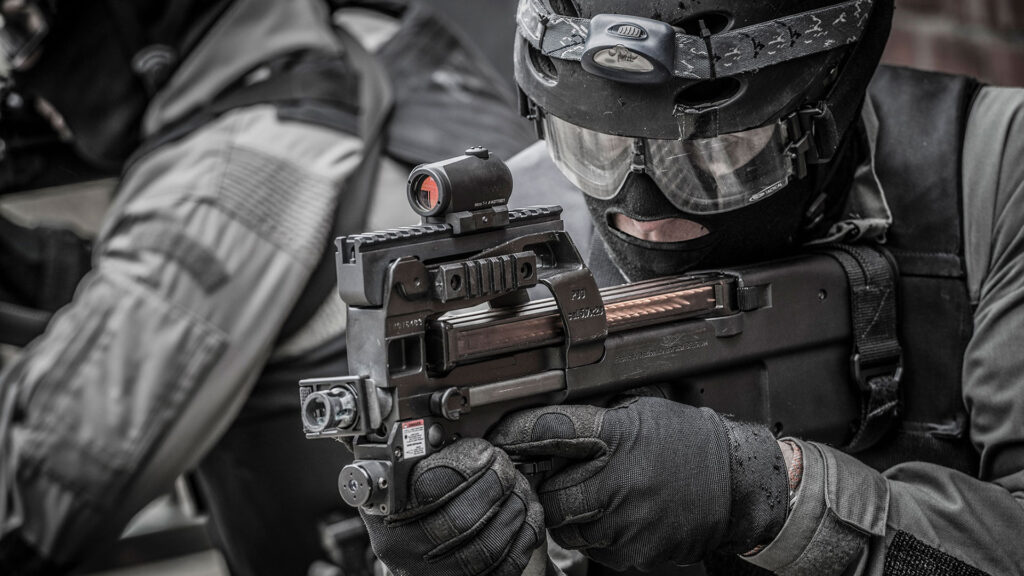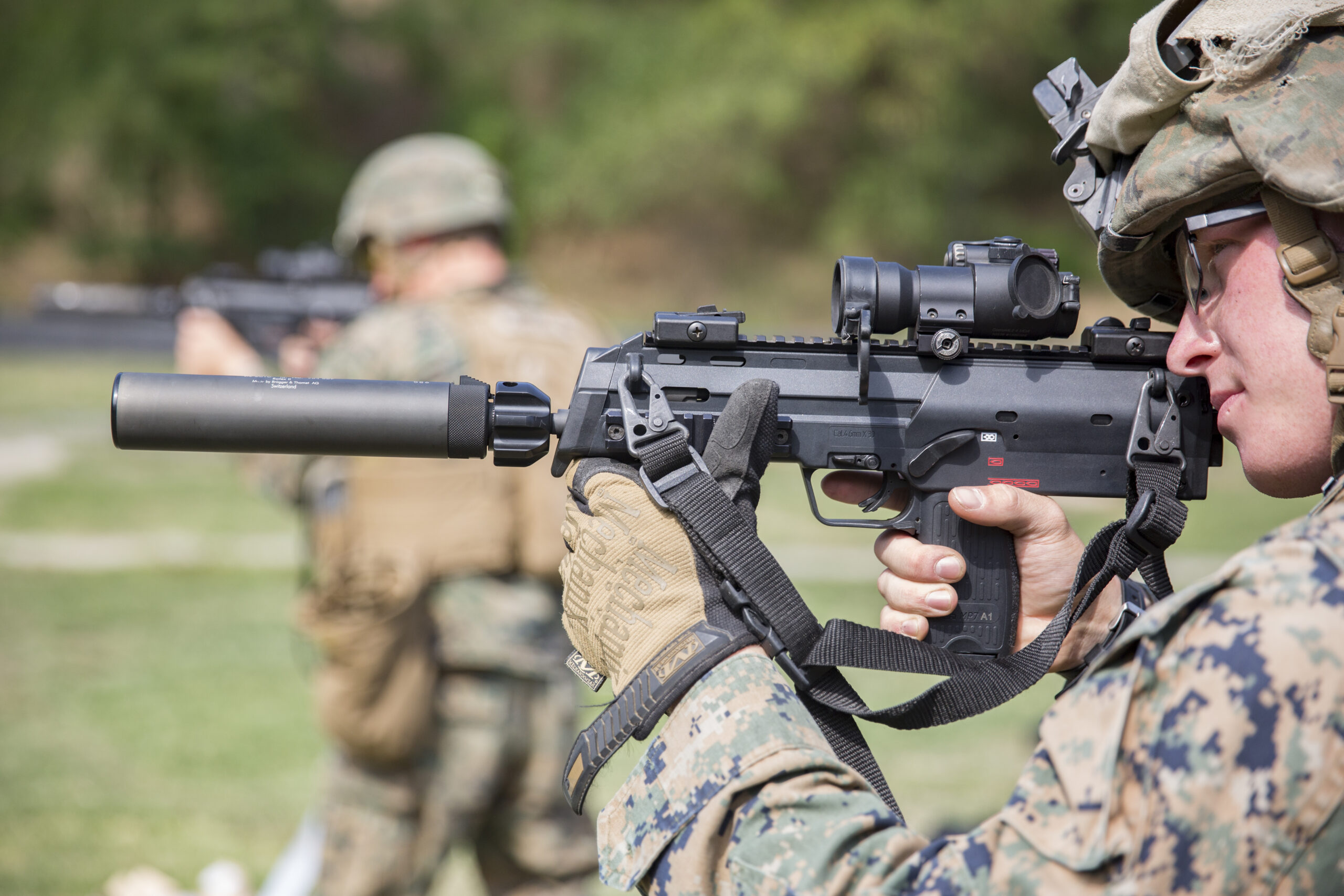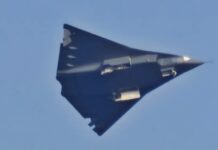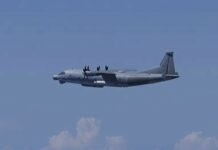The personal defence weapon is a relatively recent development in terms of small arms, emerging in the 1980s in response to a NATO requirement for a new weapons system that would potentially replace the submachine gun and the pistol in certain applications. Yet thus far, disruption seems to have been relatively minimal.
The military pistol market does not seem to have been constrained by emergence of the personal defence weapon (PDW), as evidenced by the US Army modular handgun system (MHS) programme for a new pistol, in which SIG Sauer was selected to supply M17 and M18 pistols in 9 × 19 mm. Elsewhere, the British and French opted for the ever-popular Glock design, also in 9 × 19 mm.

The 9 × 19 mm round was developed by Georg Luger – of Luger pistol fame – in 1902 and still remains a frontline round for military and law enforcement applications some 125 years later. As a round, 9 × 19 mm is still an effective solution offering more than satisfactory performance; its longevity proves that assessment. However, by the 1980s, the ability of body armour, particularly Soviet body armour, to resist penetration by 9 × 19 mm rounds had become an issue of concern for NATO. Hence their decision to support the development of the PDW and a new round that could defeat the existing and future threat of body armour.
In the 1970s and into the 1980s, most NATO member countries were using 7.62 × 51 mm battle rifles, the obvious exception being the US which had adopted the M16 in 5.56 × 45 mm. The issue with the battle rifle was that it was simply not feasible to equip all personnel with it; for example, armoured vehicle crews would need a weapon that would not take up so much room in the confined space of an armoured vehicle, thus the provision of SMGs was logical in these circumstances. Personnel with crew-served weapons would be equipped with an SMG or pistol, while support and/or second line personnel would be equipped in a similar manner. Essentially, if you were not infantry, you were more likely to be equipped with an SMG or a pistol.
It became increasingly obvious that if a conflict was to break out between NATO and Warsaw Pact forces, it would not be a conflict confined to defined frontlines. Troops in rear areas providing logistics, maintenance and support functions would find themselves facing hostile ground forces, whether they be airborne forces or units that had penetrated into rear areas. In these circumstances, friendly forces needed to be able to protect themselves and the limited penetration capabilities of the 9 × 19 mm round in SMGs and pistols would make that an extremely difficult proposition. This made an important argument for PDW development.
Parameters
If the solution to the PDW conundrum was a new weapon accompanied by a new round, then there had to be an agreed testing process to determine whether the proposed PDW and new round had the capability to defeat available body armour. This led to the Collaborative Research into Small Arms Technology (CRISAT) studies programme and the development of the CRISAT target. The target consisted of one 1.6 mm Grade 5 Titanium plate and 20 layers of Kevlar; this target array was later standardised under NATO STANAG 4512 as the ‘dismounted combatant target’, against which small arms effectiveness would be measured.
If there was one thing Europe was not short of, it was small arms designers and manufacturers. Given that this NATO requirement provided standardisation for both the weapon and its accompanying ammunition, it can be assumed that those tasked with finding a PDW solution would face an overwhelming number of proposals. That was not the case, however, and very few attempted to respond to NATO’s PDW challenge.

This requirement led to the development of the M1 Carbine, a semi-automatic weapon using the 7.62 × 33 mm (.30 Carbine) round, with a 15-round magazine, and weighing 2.6 kg. The later M2 variant was a select-fire weapon with a 30-round magazine. The weapon remained in service with the US military until the early 1970s, and is still in service with military and paramilitary forces worldwide today. The M1/M2 did receive criticism for a perceived lack of stopping power, though it was effective, providing more performance than .45 ACP weapons and less of a weight burden than the Garand. It met many of the requirements that would emerge in the 1980s’ search for a PDW solution.
In the 1960s, the M1 Carbine was tested with a new round, the 5.7 × 33 mm or .22 MMJ Spitfire, developed by Colonel Melvin Johnson USMC, who had previously developed the M1941 Johnson rifle and machine gun. Converting the M1 Carbine to use the new round delivered improved performance, but by this point the US military was adopting the M16 in 5.56 × 45 mm and saw no need to rejuvenate the old M1. As we shall see though, a 5.7 mm calibre round would go on to play a major role in the development of the modern PDW.
Meeting the challenge
FN Browning in Belgium would rise to meet the PDW challenge. Their idea was that the PDW system would be of a compact size and of minimal weight, would have a large capacity magazine, and be both simple to operate and simple to maintain. The weapon would require a new round to be developed, which would be accurate and offer a range of over 200 m. Most importantly, it would be able to penetrate the CRISAT target, demonstrating that it had the required stopping power.

FN Browning would go on to further develop their 5.7 × 28 mm family of weapons introducing the Five-seveN pistol, currently in the FN Five-seveN Mk3 MRD configuration. This is a single action, delayed blowback, semi-automatic pistol, with a 20-round magazine. weighing some 805 g fully loaded. The Five-seveN offers the user considerable performance in an easy-to-handle format that is pleasant to fire. When the P90 and the Five-seveN arrived on the scene, most would be forgiven for believing that the PDW conundrum set by NATO in the 1980s had been conclusively answered. As we shall see, there were a number of reasons why the PDW requirement would not be resolved.
The first reason was simply down to timing; trying to get various NATO countries invest in a new weapon accompanied by a new round in the 1990s after the Cold War had ended, while most of Europe was seeking the ‘peace dividend’, was always going to be a difficult ask. Another factor that came into play was ammunition, since there was a huge number of suppliers of 9 × 19 mm ammunition servicing military, paramilitary, law enforcement and commercial customers; as a result, the cost per round was cheap. Introducing a new round, with one manufacturer producing it on a limited basis, the cost per round was always going to be far higher than that of 9 × 19 mm. Add that to a reluctance to spend money on new weapons in a post-Cold War environment and it was understandable that NATO PDW efforts made little progress.
In the middle of this uncertainty regarding the future of the PDW requirement, matters became more complicated as another PDW contender emerged in the form of the MP7 from HK in Germany. Design work started in 1990, and production began in 2001. The HK MP7 is a compact, select fire weapon; it weighs 1.8 kg and utilises the HK-developed 4.6 × 30 mm round, with magazine options for 20, 30 and 40 rounds available. The MP7 met the criteria for CRISAT target penetration and was a credible solution to the PDW requirement. Subsequently, a full range of 4.6 × 30 mm ammunition types for the MP7 were developed and fielded.

Although the PDW has thus far not achieved the dominant position anticipated as a replacement for the pistol and SMG, it has nonetheless been successful in terms of achieving sales. Ironically these days, both the P90 and the MP7 are referred to as SMGs, though this has not harmed their ability to be selected by Special Forces, paramilitary units and law enforcement worldwide. Beyond military users, the P90 is employed by the US Secret Service, while the MP7 was purchased in substantial numbers by the British Ministry of Defence (MOD) Police and is even utilised by the Swiss Guard in the Vatican.
What next?
It would appear from looking at recent acquisition programmes, that the majority opinion seems to be that the best replacement solution for a 9 × 19 mm pistol is a more modern 9 × 19 mm pistol. While requirements for a new SMG can be filled by the PDWs we have discussed, there are also plenty of 9 × 19 mm SMGs to consider, such as those from B&T in Switzerland with the MP9 as adopted by the Swiss Army, CZ with the Scorpion EVO 3 in the Czech Republic, the SIG Sauer MPX in the US, and even the ST Kinetics Compact Personal Weapon (CPW) offered in 9 × 19 mm, 4.6 × 30 mm and 5.7 × 28 mm calibres. Widen your search parameters and there is a profusion of SMGs available, some with multi-calibre possibilities instead of just 9 × 19 mm.

One possible solution to this is to work on the 9 × 19 mm and provide it with a ‘hotter load’ to increase muzzle velocity and stopping power; there have been a number of Russian efforts in this regard. One Russian solution is the 9 × 21 mm SP-10 Gyurza round – this high-power round penetrates body armour and was developed to meet the requirements of the Russian Federal Security Service (FSB) to be used in connection with the Serdyukov SR-1 Vektor pistol and SR-2 Veresk SMG. Interestingly, the Russian Army looked at the Serdyukov pistol and rejected it in favour of a different 9 × 19 mm pistol design. There was also an armour-piercing 9 × 30 mm round developed for SMG use in Russia.
There have been and still are numerous efforts to develop new rounds to potentially replace or supplement the 9 × 19 mm for SMG and pistol applications. Possibilities have emerged in the Czech Republic, Sweden, and the US, amongst others. China has the 5.8 × 21 mm DAP 92 round, which has PDW parameters in terms of defeating body armour; this is utilised by the QCQ-05 SMG and the QSZ-92 in Chinese military service. The Chinese manufacturer also offers both weapons in 9 × 19 mm. Whilst the PDW has never dominated in terms of small arms, many of its key attributes have come to be fielded in current SMG and pistol applications.
David Saw













